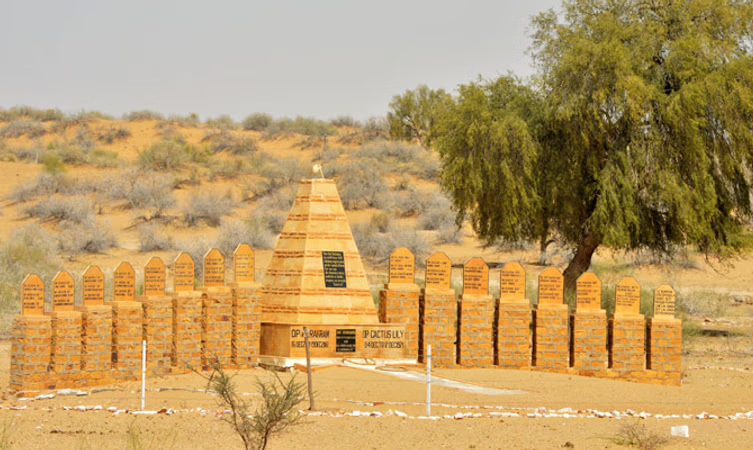The Longewala War Memorial, located in the vast, arid expanse of the Thar Desert, stands as a solemn and powerful tribute to the courage and sacrifice of the Indian soldiers who fought in the Battle of Longewala during the Indo-Pakistani War of 1971. This memorial is not just a collection of monuments; it is a living testament to one of the most iconic and decisive battles in modern Indian military history. It reminds visitors of a pivotal moment when a small, determined force of Indian soldiers, against all odds, defended their post and ultimately thwarted a major Pakistani offensive.
The Battle of Longewala, which began on the night of December 4, 1971, pitted approximately 120 Indian soldiers of the 23rd Battalion, Punjab Regiment, led by Major Kuldip Singh Chandpuri, against a formidable Pakistani brigade of around 2,000 to 3,000 soldiers, supported by a significant number of tanks and heavy artillery. The Pakistani plan was to launch a swift and devastating assault, capturing the Longewala post and then advancing deep into Indian territory. However, the Indian defenders, despite being heavily outnumbered and outgunned, refused to retreat. They fought with extraordinary bravery, utilizing the terrain and a few strategically placed anti-tank mines to hold off the advancing enemy.
The Battle of Longewala
The Battle of Longewala is considered one of the most heroic and decisive battles in Indian military history. It occurred on the night of December 4-5, 1971, when a small contingent of around 120 Indian soldiers from the 23rd Battalion of the Punjab Regiment, led by Major Kuldip Singh Chandpuri, faced an overwhelming Pakistani force. The Pakistani attack consisted of approximately 4,000 soldiers, 40-45 tanks (T-59 and Sherman tanks), and an artillery battery.
Despite being heavily outnumbered and outgunned, the Indian soldiers held their ground and defended their post with immense bravery. They used their limited resources, including a jeep-mounted recoilless gun, to destroy several enemy tanks and stall the Pakistani advance. A key factor in their defense was the delay caused by a fake anti-tank minefield they had laid, which made the Pakistani forces hesitant to advance over the open terrain.
At dawn, the Indian Air Force (IAF) came to their aid. Hunter aircraft from the 122 Squadron, based in Jaisalmer, wreaked havoc on the Pakistani forces, destroying dozens of tanks and vehicles. This air support, combined with the courageous stand of the Indian soldiers, resulted in a decisive Indian victory. The Pakistani forces suffered significant casualties and were forced to withdraw, halting their planned advance on Jaisalmer.
The heroic defense of Longewala has been immortalized in the popular Bollywood movie “Border.”
The War Memorial
The Longewala War Memorial was established to commemorate the valor and sacrifice of the soldiers who fought in this battle. Maintained by the Indian Army, it serves as a powerful reminder of the event.
The memorial complex includes:
- A museum and a gallery: These display photographs, artifacts, and personal stories of the soldiers who participated in the battle. You can see weapons, uniforms, and other remnants from the war.
- Military equipment: On display are various military vehicles, including captured Pakistani tanks (like the T-59 and Sherman tanks) that were destroyed in the battle. The preserved Vijayanta tank, which played a crucial role in the battle, is a major highlight.
- An audio-visual room: Visitors can watch a short film that provides a detailed account of the battle.
- An obelisk and eternal flame: These stand as a symbol of remembrance and gratitude for the soldiers who gave their lives for the nation.
Visiting the Memorial
- Location: The memorial is situated close to the India-Pakistan border, which gives visitors a sense of the arid desert landscape where the conflict unfolded.
- Timings: The memorial is generally open daily from 8:00 AM to 6:00 PM.
- Entry Fee: Entry to the memorial is free, though there may be a small fee to watch the war film in the audio-visual room.
- Best time to visit: The winter months (November to February) are recommended for visiting, as the weather is more comfortable for exploring the desert region.
A visit to the Longewala War Memorial is not only a chance to learn about a significant moment in Indian history but also an opportunity to pay tribute to the courage and patriotism of the Indian armed forces.
